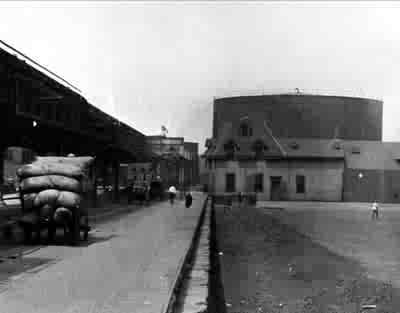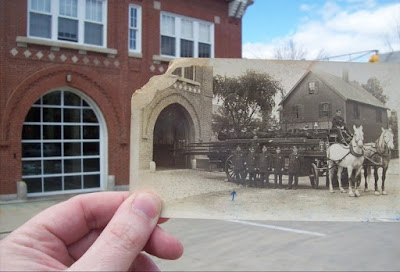On January 15, 1919 a large storage tank containing molasses burst in Boston's North End unleashing a huge wave of sticky destruction. A small plaque on Commercial Street commemorates the disaster.
Molasses, waist deep, covered the street and swirled and bubbled about the wreckage. Here and there struggled a form — whether it was animal or human being was impossible to tell....
An urban legend claims that the doomed tank might have been overfilled in late 1918 so that the owners could produce as much rum as possible before Prohibition came into effect. However, Purity Distilling did not make rum, but rather specialized in the production of industrial alcohol.
I believe the vintage picture on the left was taken from an elevated train line that ran through the area, a somewhat approximate view from Copp's Hill today on the right.
The explosion at the tank sent a 40 foot wave through the streets of the North End crushing buildings and killing 21 people. A further 150 were injured in the sticky mess.
My Great-Grandfather was a Cambridge fireman, when we were young my Grandfather told us that his firehouse responded to the disaster, and he as a child my Grandfather had seen the aftermath. I tracked down my Great-Grandfather's fire station in the Observatory Hill section of Cambridge- he's pointed out in the vintage photo. Today several books have been written about the "Great Molasses Flood" including Dark Tide: The Great Boston Molasses Flood of 1919 by Stephen Puleo, or Deborah Kops The Great Molasses Flood: Boston, 1919 and you'll find numerous on-line articles about the event- but as a child I wasn't sure if my Grandfather's story was just a tall tale for us kids. The sticky wave that swept through Boston seemed to fantastic to be real.
It's shame we didn't record his story or his memories of the event. The first hand account would be fascinating to hear again. Next year (2019) will mark the 100th anniversary of the event.
For more information check out these entries on Wikipedia, or Atlas Obscura or click the links above to check out the books with some more in depth history.






No comments:
Post a Comment